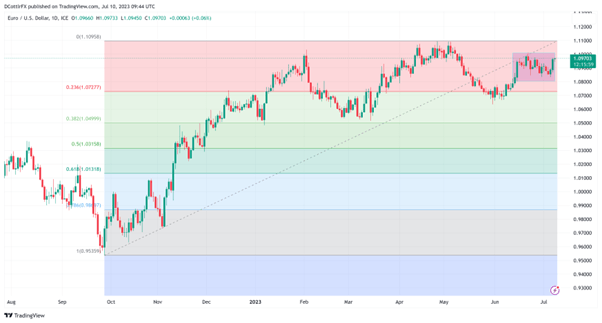EURUSD Holds Post-Payroll Gains, Market Weighs Rate-Rise Chances
EURUSD Prices, Charts, and Analysis
- EUR/USD remains close to one-week highs
- Markets think rates are going up on both sides of the pair
- But the EUR side may have more work to do
Recommended by David Cottle
Download our Brand New Q3 Euro Guide
The Euro weakened a little on Monday but managed to hang on to most of the gains seen against the United States Dollar last week, a week that ended on a high note for single-currency bulls.
The greenback took a hit after official US employment data in which headline June nonfarm-payroll growth missed expectations. They rose by only 209,000 when the market had hoped for 250,000. This in turn stoked suspicions that the Federal Reserve might have less scope to raise interest rates without causing economic damage.
Markets still think US rates will go up, probably as soon as this month. But it’s fair to say there’s now a little more doubt around the magnitude and duration of any further rises, even if that could change with the next key data release.
On the ‘EUR’ side of EUR/USD, of course, markets are equally sure that borrowing costs will have to rise to combat sticky inflation in many Eurozone economies, notably Germany. European Central Bank President Christine Lagarde has dropped heavy hints that she finds more rises appropriate, and soon.
However, national economies within the Eurozone aren’t created equal, either in their inflation levels or resilience to higher rates. For example, German politicians seem more sanguine about the need for hikes than their counterparts in Italy. Last week the Bank of Italy’s Governor Ignazio Visco said that, in his view, the ECB could contain inflation by holding rates steady at current levels for longer rather than by raising them again. This take would appear to place him at odds with the leadership at Germany’s Bundesbank who seem far more solidly behind Lagarde.
The Euro could start to struggle if these rhetorical cracks are seen to widen.
Still, the currency seems to be trading essentially sideways against the Dollar, as it often does during the Northern Hemisphere summer, albeit at quite elevated levels. There’s not a huge amount of first-tier economic data on track this week for traders to bite down on, but German inflation and sentiment numbers due on Tuesday will attract attention, as will official Consumer Price Index figures out of the US on Wednesday.
| Change in | Longs | Shorts | OI |
| Daily | 11% | 4% | 6% |
| Weekly | -15% | 18% | 3% |
EUR/USD Technical Analysis
Chart Compiled Using TradingView
EUR/USD has spent the last couple of weeks trading in a quite well-defined trading band between June 22’s intraday peak of 1.10092 and June 14’s low of 1.07990.
There seems little appetite to push the boundaries of this band either in a bullish attempt at April 26’s 13-month peak of 1.10958 or on the downside to key support at 1.07277. That’s where the first Fibonacci retracement of the rise from last September’s lows to that April peak comes in. The longer this trading range remains intact, the more likely any break is to provide a meaningful directional cue. The pair remains perhaps uncomfortably above a range of moving averages, with the 100-day coming in well below the market at 1.0826.
This may be a cause for concern among Euro bulls, a breed getting rarer anyway according to IG’s own sentiment data. This finds only 38% of traders now bullish, This may not mean that EUR/USD is in for a significant reversal, but perhaps a renewed test of that downside range limit just below 1.08 looks more likely than a try at the top this week.
—By David Cottle for DailyFX



Comments are closed.